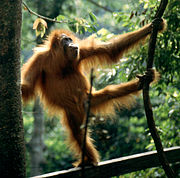Portal:Indonesia/AOTW/7, 2007
Sumatra is the sixth largest island of the world (approximately 470,000 km²) and is the largest island entirely in Indonesia (two larger islands, Borneo and New Guinea, are partially in Indonesia). With its location in the India-China sea trade route, several trading towns flourished, especially in the eastern coast, and were influenced by Indian religions. The most notable of these were the Srivijaya and the Sumudra.
On December 26, 2004, the western coast and islands of Sumatra, particularly Aceh province, were devastated by a nearly 15 metre high tsunami following the 9.2-magnitude Indian Ocean earthquake. The interior of the island is dominated by two geographical regions: the Barisan Mountains in the west and swampy plains in the east. Even if mostly unsuitable for farming, the area is currently of great economic importance for Indonesia. It produces oil from both above and below the soil—palm oil and petroleum.
The island is home to a host of species including: Sumatran Pine, Rafflesia arnoldii (world's largest flower), Titan arum (world's tallest flower), Sumatran Tiger, Orangutan, Sumatran Rhinoceros, Sumatran Elephant, Malayan Tapir, Malayan Sun Bear, Clouded Leopard, and many birds and butterflies. The island includes more than 10 National Parks, including 3 which are listed as the Tropical Rainforest Heritage of Sumatra World Heritage Site—Gunung Leuser National Park, Kerinci Seblat National Park and Bukit Barisan Selatan National Park. (Read more...)

